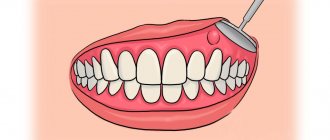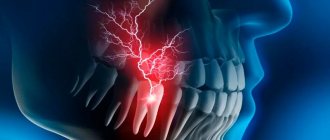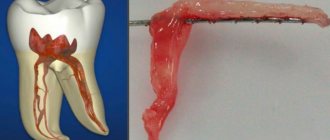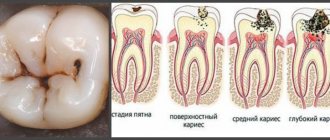The Greek word "kystis", used to refer to a condition such as a dental cyst, is translated as "blister". This name most accurately reflects the essence of this disease. With it, a cavity is formed at the root of the tooth, which is filled with liquid (bacteria and dead cells), and the comparison with a bubble in this case is most appropriate.
The consequences of untimely treatment of a cyst in the gum of a tooth can be the most unpleasant - including tooth loss. The process may also involve neighboring teeth, which will also require professional dental treatment.
Resection of the root apex (frontal group) - 6,500 rubles.
Resection of the root apex (chewing group) - RUB 9,000.
At CELT you can get advice from a dental specialist.
- The cost of a dental consultation is 1,000
- The cost of an orthodontist consultation is 2,000
Make an appointment
Cyst symptoms
In the initial stages, the cyst is almost invisible. Unlike an abscess, it does not break out, but at the same time continues its development inside, affects healthy tissue of the jaw bone and leads to loosening of the tooth. As the inflammatory process develops, the following symptoms of a cyst in the tooth appear:
- pain in the affected area;
- swelling of the gums;
- increased body temperature;
- swollen and tender lymph nodes;
- flux.
The pathology quickly develops into a chronic stage and is asymptomatic for humans. During an exacerbation, attacks of pain may occur when eating solid foods. Gradually, the tooth enamel becomes gray or yellow, and the tooth shifts. As soon as the immune system fails due to acute respiratory viral infections or exacerbation of chronic diseases, the growth of the cyst accelerates, so the appearance of a fistula, swelling, acute pain, fever and migraine is observed.
Indications
- Bite abnormalities.
- Periodontitis.
- Installation of orthodontic systems.
- Severe deformation of the ligamentous apparatus (tooth loosening).
- Hyperdontia.
Contraindications
- ARVI and weak immunity.
- Chronic and acute forms of diseases of the cardiovascular system.
- Nervous and mental disorders.
- Cancerous tumors.
Healing of psychosomatics on the right side of the face using Spiritual Integration techniques.
Effective methods of rapid diagnosis and healing are offered by the author's development of K. N. Dovlatov - Spiritual Integration. This progressive psychologist, coach, candidate of psychological sciences, has developed a unique and one-of-a-kind system for interacting with one’s own soul.
Using the methods and developments of Spiritual Integration , a person gets the opportunity to independently, in the shortest possible time, realize the real, true origins of their diseases and problems. But the main thing is not only to understand, but to be in a state of high vibrations, using the strength and power of your soul, to get rid of diseases and troubles.
Diseases that are incurable, from the point of view of official medicine, disappear. Psychosomatics of the right side of the face and its other diseases are no exception. The very name of the system encrypts the explanation that obtaining one’s own integrity occurs at the level of subtle, spiritual plans. reintegration should be highlighted .
This technique allows for communication at the level of human souls. Sounds like a fairy tale? And then a miracle happens - a person turns to Spiritual Integration to solve a specific problem, and as a result, gains a general strengthening of his health and life in general. At the same time, training in the techniques and methods of this system is open to everyone, both through live training and through online training.
Why does a cyst appear?
The causes of the appearance of a dental cyst, a photo of which can be seen in this article, are injuries due to mechanical stress or infection, which leads to the development of inflammation of the tissues surrounding the tooth. A tooth inside the gum can be injured under a variety of circumstances, for example, when the tooth is hit or when chewing nuts. As for infection, it can get into the root canal if dental treatment is performed incorrectly, in particular, if the dental canal is incompletely filled. A cyst that arose as a result of sinusitis or another infectious disease is relatively rare. In this case, pathogenic microorganisms enter the gums along with the blood flow.
Get free access to watch the webinar by Konstantin Dovlatov
If you want to know more about psychosomatics, follow the link below
GO TO WEBINAR
With our teeth we gnaw, bite, chew, chew, bite off, nibble, tear, grind - all verbs indicate that teeth are given to us to express aggression. And any aggression is a violation of the integrity of something or someone. Here was a whole apple - they took a bite (performed an act of aggression, violated the integrity of the apple) - and it turned out to be the well-known symbol -apple)) And if someone encroaches on our integrity (territory, emotional comfort, life, health, well-being), then, - good, here it would be necessary to turn on the “tit for tat” mode so that these same teeth don’t hurt, but... there are so many different reasons not to do this, or to want to and not do it, or not to know how exactly to do it, that Dental psychosomatics have plenty of room to roam!
Register for Elmira Dovlatova’s free webinar “How to solve problems using metaphorical maps.”
And you will receive a practical tool for quickly diagnosing and treating any disease. Hurry up to get it!
How does the disease develop?
The process begins with periodontitis, when the tissue located between the jaw bone and the tooth root becomes inflamed. As a result, the tissues located around the root begin to grow abnormally. Initially, the size of the neoplasm does not exceed five millimeters (it is called a granuloma). Growing and enlarging, it becomes covered with a membrane and transforms into a cyst.
There are cases when the cyst grows so much that it eats away the bone around the tooth. With the next exacerbation of inflammation, it opens, forming a channel to the outside through the gum mucosa. Such a channel is called a fistula or fistula tract.
It is worth noting once again the insidiousness of this disease, which not only negatively affects the condition of the roots of the teeth, but also affects the general condition of a person. At the initial stage, the pathology develops almost imperceptibly and can only be detected during a visit to the dentist. Pronounced symptoms appear in the later stages of the disease as a result of tumor growth and destruction of bone tissue.
The main danger of a cyst is the fact that, by corroding the bone, it deprives the patient of the opportunity to install an implant in place of a lost tooth without complex manipulations.
Diagnosis of periodontal disease
The disease is treated by a periodontist or dental therapist. Diagnostic methods:
- Taking anamnesis and examining the oral cavity. This is how the doctor assesses the severity of the disease and, in part, determines the causes of its occurrence. During the examination, the doctor uses a diagnostic scale and dental instruments.
- Radiography. The main method of diagnosis. Helps assess the level of periodontal septa and the condition of interdental spaces. The image can be intraoral or panoramic.
- Orthopantomogram (panoramic image of the dental system). X-ray radiation is focused on a specific part of the jaw, the resulting image will be displayed on a monitor screen or on film. The method is painless, the radiation dose is negligible. This way you can assess the strength of blood flow in the gums and the degree of bone destruction.
- Echoostemetry. An ultrasound test that measures bone density.
- Analysis of the composition of saliva and oral microflora.
- Study on the Schiller-Pisarev dental test. The affected gum is treated with iodine, this makes it possible to assess the degree of damage to the soft tissues.
- Polarography. Electrochemical analysis of substances, it is based on the use of electrodes. This way you can assess how saturated the gum tissue is with oxygen;
- Laboratory research. These are clinical and general blood tests (diagnostically important indicator - ESR).
The development of periodontal disease is often associated with diseases of the internal organs. Therefore, you may need to consult with specialized specialists - a therapist, gastroenterologist, oncologist, endocrinologist.
What complications does a dental cyst lead to?
Untimely treatment or removal will lead to the following complications:
- Periostitis.
- Swelling.
- Abscess.
- Phlegmon.
- Temperature increase.
Usually the cyst does not make itself felt in any way, so complications may appear unexpectedly. To exclude serious consequences, you need to be examined by a dentist at least once every six months. The appearance of a capsule with pus can occur against the background of deep caries or severe inflammation of the gums, so do not delay a visit to a specialist.
The lack of results with conservative treatment leads to the fact that the cyst has to be removed along with the tooth.
SMELL FROM THE MOUTH
Liz Burbo in her book “Your Body Says Love Yourself!” writes about possible metaphysical causes of bad breath.
A healthy person's breath has virtually no odor. Bad breath can be caused by a physical disease - DIGESTIVE disorder, DENTAL CARIES, etc. The description below applies primarily to cases where bad breath is not associated with any pathology.
Emotional blockage.
A bad smell of this kind comes as if from the depths of a person’s soul and indicates that this person is experiencing severe internal pain, as well as hatred, anger and a thirst for revenge - towards himself or towards people who have somehow hurt him. Thoughts about this cause him deep shame - that's why he doesn't even want to acknowledge them - and gradually kill him from the inside. With the help of this unpleasant smell, he keeps people close to him at a distance, although in fact he needs their presence more than anything else.
Mental blockage.
If you think you have bad breath, ask a few people who know you well. Find out if this smell is associated with any disease. If not, then this means that you should reconsider your attitude towards some things, since it greatly harms you. There is no wound that cannot be healed by true forgiveness. You don't have to feel helpless anymore. Also get rid of the false shame that you have maintained within yourself for so long. Tell yourself that you are a nice, pleasant person, and become like that in reality.
Bodo Baginski and Sharamon Shalila in their book “Reiki - the Universal Energy of Life” write about possible metaphysical causes of bad breath.
You breathe out what is in your thoughts, and if it smells bad, then something in your intentions is rotten or spoiled. And in this case, the symptom makes us honest with ourselves and shows what we are like internally. Therefore, pay attention to the world of your thoughts, what are they primarily aimed at? If your thoughts are again filled with love, friendliness and honesty, then you will exhale only goodness, your breath will again become pure and others will again be able to enjoy smelling you.
And here Reiki will lead you to self-knowledge.
Dr. Valery V. Sinelnikov in his book “Love Your Disease” writes about possible metaphysical causes of bad breath.
Your “dirty” thoughts and feelings, your past are so outdated that they have already “stinked”. It's time to bring something new and fresh into your life.
A young guy came to see me. He held a handkerchief near his mouth.
“Doctor,” he said, “a year ago I started having bad breath.” I don't know what this is connected with. — Maybe from inflammation in the nasopharynx?
“But the doctors examined me and found nothing.” And I feel that something is wrong there.
From communicating with the subconscious, it turned out that the cause of the problem was an unpleasant situation that happened just a year ago. And now, for a year now, the guy has been harboring anger and a desire for revenge.
I was able to convince him to reconsider his attitude towards the past and learn a positive lesson from it.
“Change your rotten old thoughts that have been preventing you from living all this time with new, fresh ones that will bring only pleasant experiences into your world,” I told him.
Louise Hay in her book “Heal Yourself” points out the main negative attitudes (leading to illness) and harmonizing thoughts (leading to healing) associated with the appearance and healing of bad breath.
Angry thoughts, thoughts of revenge. The past gets in the way.
Harmonizing thoughts: I am happy to part with the past. From now on I express only love.
Types of dental cyst
The type depends on the place of occurrence. A cyst forms in the maxillary sinus, gum, root or under the crown. To determine the type of capsule with pus, the specialist examines the medical history and assesses the client’s general health. There are 5 types of dental cysts:
- Follicular - formed when the tooth was unable to grow unhindered and most of it remained inside.
- Keratocyst - develops against the background of pathological processes during the growth of the body (the growth of the neoplasm is stimulated by the pharynx-forming tissue).
- Radicular - appears from a granuloma and is a serious complication of deep caries.
- Retention – is formed during the eruption of molars in children.
- Residual – appears due to complications and inflammatory processes after tooth extraction.
Interpretation by Liz Burbo
We need teeth to chew food. On a metaphysical level, this is similar to how we “chew” ideas, thoughts, and life circumstances for better assimilation.
If you can transform something, go through twists and turns, then a person can handle it. If not, then you can break your teeth, or even put them on the shelf. Indecision is what distinguishes people with bad teeth.
We bite with our teeth. You can't bite on a sore tooth, so this means that some events made the person unable to stand up for himself in certain events. Look back at your life – how often do your teeth hurt? How many problems did you have with them?
If you go to dentistry as a job, then indecision and helplessness accompany you through life and it’s time to change your character. If usually bad teeth are very rare for you and now you have a toothache, then remember the last important event that could have seriously undermined you.
According to Liz Burbo's interpretation, the right side reflects how the relationship with the father developed. If there are problems here, then you need to reconsider the conflicts with him that stretch from the past. Perhaps more tolerance and acceptance are needed.
Sometimes pain in the teeth on the right side does not directly indicate quarrels with the father, but rather patterns that were formed in childhood with his participation.
All his life, Alexei was angry with his father for leaving the family at the most difficult moment for his mother - when she was sick. He became the mainstay and took on more responsibility than a teenager could handle. Even then, as a child, he swore to himself that he would never leave his mother in difficult times. But much later, when he had his own family and now had to be responsible for his children and wife, Alexey could not break away. He began to visit his mother less often when she needed him. Consciously suppressing his anger, Alexei felt that he was behaving like a father. This caused severe toothache.
If the teeth hurt on the right side and a fistula forms, then the problem is somehow related to the mother or her behavior patterns.
Liz Burbo also points out that the upper front 4 teeth are a symbolic reflection of how a person relates to his parents and how he treats them. The lower 4 teeth are a reflection of what place parents actually occupy for a person.











